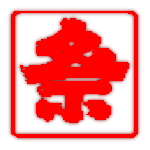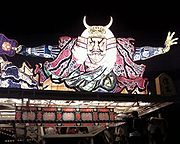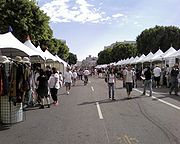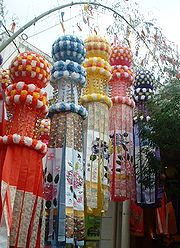
Nisei Week
Encyclopedia

Japanese American
are American people of Japanese heritage. Japanese Americans have historically been among the three largest Asian American communities, but in recent decades have become the sixth largest group at roughly 1,204,205, including those of mixed-race or mixed-ethnicity...
(JA) culture and history in Little Tokyo, Los Angeles. Nisei
Nisei
During the early years of World War II, Japanese Americans were forcibly relocated from their homes in the Pacific coast states because military leaders and public opinion combined to fan unproven fears of sabotage...
means 2nd generation in Japanese, describing the first American born Japanese, a group which the seven day festival was originally meant to attract. Though named for the Nisei generation, Nisei Week is no longer targeted at Niseis, nor is the festival still contained within a week. Nisei Week Foundation president for 2006, Michelle Suzuki, described the festival as "the opportunity for people of all backgrounds to celebrate Japanese heritage and culture".
Festivities are held over one month, though the main attractions are held during the primary two weekends of the festival in mid-August. Nisei Week draws tens of thousands of participants each year from both the Japanese community and Southern California area, mostly to its Grand Parade and specialized festivals. The 71st Annual Nisei Week will take place on August 13–21, 2011.
History and cultural analysis
Nisei Week's history began during the financially difficult era of the Great DepressionGreat Depression
The Great Depression was a severe worldwide economic depression in the decade preceding World War II. The timing of the Great Depression varied across nations, but in most countries it started in about 1929 and lasted until the late 1930s or early 1940s...
— Issei
Issei
Issei is a Japanese language term used in countries in North America, South America and Australia to specify the Japanese people first to immigrate. Their children born in the new country are referred to as Nisei , and their grandchildren are Sansei...
, first generation Japanese immigrants, were growing too old and the Gentlemen's Agreement prohibited new Japanese immigration. The English speaking Nisei became a sought after potential revenue source to support Little Tokyo businesses dominated by Issei. With Little Tokyo falling into stagnation, Nisei week was a celebration to attract Niseis and help return the district into a more exuberant and youthful area.
Mihiko Shimizu, original inventor of the festival, and other Issei business owners vied for an alliance with the Nisei run Japanese American Citizens League
Japanese American Citizens League
The was formed in 1929 to protect the rights of Japanese Americans from the state and federal governments. It fought for civil rights for Japanese Americans, assisted those in internment camps during World War II, and led a successful campaign for redress for internment from the U.S...
(JACL) to promote the festival. However, the possibility of being labelled as anti-American by anti-Japanese groups remained a concern, due to the collaboration of the two generations (American citizens and Japanese nationals) and cultural overtones of the festival. The Issei business owners decided to hand over all aspects of the celebration to the independent JACL to settle the problem. The first festival was held August 13, 1934, founded by the JACL.
Beyond economic reasons, Nisei Week week was created to promote "ethnic solidarity". Utilizing Nisei Week's cultural environment, by centering it in the heart of Little Tokyo and holding cultural events, Issei hoped to bring Nisei back into the cultural fold of the older generation. Issei also hoped for Nisei to become brokers between Little Tokyo and the dominant society around it. The creation of the Nisei Week Queen, one year after the first Nisei Week in 1935, may be seen as the epitome of cultural mediation and broker between the Japanese community and white America. Mike Haigwara, Nisei Week's 2007 Street Arts and Carnival director, attributes Nisei Week with helping foster Japanese American identity and self-esteem.
Japanese internment
Japanese internment
Japanese internment is a term generally used to refer to one or both of the following events:*Japanese American internment, the internment of Japanese Americans in the United States during World War II...
presented another tumultuous and racially charged period for Nisei Week and the greater Japanese community. Executive Order 9066
Executive Order 9066
United States Executive Order 9066 was a United States presidential executive order signed and issued during World War II by U.S. President Franklin D. Roosevelt on February 19, 1942 authorizing the Secretary of War to prescribe certain areas as military zones...
was initiated in 1942, relocating and confining Japanese Americans to internment camps, including those running Nisei Week. The festival has been running continuously, except the years during and immediately after internment. Nisei Week celebrated its 50th anniversary in 1990, shifted from 6 years of inactivity during the WWII era. Despite obstacles, Nisei Week is the longest running Japanese festival in California, celebrating its 66th birthday in 2006.
Retrospectively, the celebration was seen by Time Magazine as dual reminder: "Unofficially, it recalls an ugly footnote to American history: the World War II evacuation and internment of more than 110,000 West Coast Japanese, most of them native-born U.S. citizens." Lon Kurashige, professor of ethnic studies at USC
University of Southern California
The University of Southern California is a private, not-for-profit, nonsectarian, research university located in Los Angeles, California, United States. USC was founded in 1880, making it California's oldest private research university...
, proposes that the lingering effects of internment changed Nisei Week's cultural tones and affiliations, in part due to the weakening role of men during the internment period, which again shifted during and after the civil rights period.
Phillip Morris
Philip Morris USA
Philip Morris USA is the United States tobacco division of Altria Group, Inc. Philip Morris USA brands include Marlboro, Virginia Slims, Benson and Hedges, Merit, Parliament, Alpine, Basic, Cambridge, Bucks, Dave's, Chesterfield, Collector's Choice, Commander, English Ovals, Lark, L&M, Players and...
' first promotional event targeted at Asian and Pacific Islander American community events was staged at Nisei Week. The event was part of a larger "PULL strategy" program, which included marketing to increase brand recognition among Asians. A Marlboro booth provided samples and attempted to attract consumers by displaying a Marlboro Formula One
Formula One
Formula One, also known as Formula 1 or F1 and referred to officially as the FIA Formula One World Championship, is the highest class of single seater auto racing sanctioned by the Fédération Internationale de l'Automobile . The "formula" designation in the name refers to a set of rules with which...
car at the 1988 Nisei Week festival.
"Aki the Akita", Nisei Week's official mascot, was created by renowned mascot artist Dick Sakahara in 1997 for Nisei Week's now defunct Dog Show . Aki appears as a costumed character to greet and entertain children, or in cartoon form as a symbol for the festival.
Festivities
Nisei Week has many attractions and exhibitions, which change annually, though many traditions remain each year.Nisei Week Grand Parade

Ondo
Ondo is the name of:* Ondo , a style of Japanese folk music* Ondo, Hiroshima, a town in Japan* Ondo City in Nigeria* Ondo State in Nigeria* Ondo Phone in Europe...
dancing groups, martial art dojos, elected parade marshals (usually celebrities or community heroes), Japanese and local politicians (such as the Mayor of Los Angeles), a mikoshi
Mikoshi
A is a divine palanquin . Shinto followers believe that it serves as the vehicle to transport a deity in Japan while moving between main shrine and temporary shrine during a festival or when moving to a new shrine...
shrine, floats, pageant queens, taiko
Taiko
means "drum" in Japanese . Outside Japan, the word is often used to refer to any of the various Japanese drums and to the relatively recent art-form of ensemble taiko drumming...
players, etc. Spanning several hours, the Nisei Week Parade lasts long due to its many participants and slow walk pace of traditional Japanese dancers.
Aomori Nebuta, a famous festival within Japan, presented an imported parade float at the 2007 Grand Parade. The parade took place on August 19, at 6pm, in order for the float's lights to be visible after nightfall.
The 2011 parade on August 14 featured former Los Angeles Dodgers
Los Angeles Dodgers
The Los Angeles Dodgers are a professional baseball team based in Los Angeles, California. The Dodgers are members of Major League Baseball's National League West Division. Established in 1883, the team originated in Brooklyn, New York, where it was known by a number of nicknames before becoming...
manager Tommy Lasorda
Tommy Lasorda
Thomas Charles Lasorda is a former Major League baseball player and manager. marked his sixth decade in one capacity or another with the Brooklyn/Los Angeles Dodgers organization, the longest non-continuous tenure anyone has had with the team, edging Dodger broadcaster Vin Scully...
as grand marshal. American figure skater Mirai Nagasu
Mirai Nagasu
Mirai Aileen Nagasu , born April 16, 1993 is an American figure skater. She is the 2008 U.S. national champion, 2010 U.S. silver medalist, 2011 Four Continents bronze medalist, and 2007–2008 Junior Grand Prix Final champion....
, American actress and singer Gina Hiraizumi
Gina Hiraizumi
Gina Hiraizumi is an American actress and singer. Her father is a third generation Japanese American and her mother is from Japan. She is Yonsei or part of the fourth generation Nikkei....
, Japanese singer and TV personality Kenichi Mikawa
Kenichi Mikawa
is a Japanese singer and TV personality, known for his outspoken views and style.Mikawa was born in Suwa, Nagano as . He recorded a number of hit songs as a male enka singer in the 1960s and 1970s. The most well-known of his songs include "Sasoriza no Onna" and "Yanagase Blues"...
have appeared in the parade.
Go For Broke and U.S. 100th Infantry Battalion Exhibits
After World War IIWorld War II
World War II, or the Second World War , was a global conflict lasting from 1939 to 1945, involving most of the world's nations—including all of the great powers—eventually forming two opposing military alliances: the Allies and the Axis...
, exhibits were introduced about internment camps and JA veterans, including those of the U.S. 100th Infantry Battalion
U.S. 100th Infantry Battalion
The 100th Infantry Battalion was a unit within the US Army's 34th Infantry Division during World War II. The primarily Nisei battalion was composed largely of former members of the Hawaii Army National Guard...
. Currently, the Japanese American National Museum
Japanese American National Museum
The opened its doors in 1992. The idea for the museum was originally thought up by Bruce Kaji with help from other notable Japanese American people at the time. The museum is located in the Little Tokyo an area near downtown Los Angeles, California. It is devoted to preserving the history and...
(JANM) and Go For Broke Monument
Go For Broke Monument
The Go For Broke Monument in Little Tokyo, Los Angeles, California commemorates Japanese Americans who served in the United States Army during World War II....
have replaced separate exhibits and the old JANM building. JA veterans still march annually in the Nisei Week Parade.
Nisei Week Car Show
The Car Show was introduced in 2000 and is produced by Mainstream Productions LLC. / Showoff Car Show. The show features import cars, exhibits, import models, along with car competitions for cash and sponsor prizes. The Car Show is one of the few admission based events at Nisei Week, covering the cash prize and logistics of a full fledge festival, including live entertainment and exhibits. The import sceneImport scene
The Import Scene or Import Racing Scene or Tuner Scene refers to the subculture that revolves around modifying imported brand cars , especially those of Japanese brands, for street racing.-History:...
is argued as both influenced and originated within the Asian American community and linked to Asian American identity.
Nisei Week Queen and Court
The 2nd annual Nisei Week introduced the Nisei Week pageant and Nisei Week Coronation Ball in 1935. The pageant was created to help reinvigorate local business and promote goodwill in the greater Los Angeles community. Today, the queen is crowned for her community service and presentation skills, with a formal coronation held for judging and celebration. New queens and princesses (part of a court marked by year) are inducted annually and featured prominently on float during the Nisei Week Parade. The Queen and Court, representing Nisei Week during community events throughout the year, were crowned at a formal dinner of 700 guests on the primary weekend of Nisei Week's festival.- 2011 Queen and Court — Queen Erika Olsen, First Princess Mimi Yang, Miss Tomodachi Kay Yamaguchi and Princesses Jessica Kanai, Melissa Nishimura, Amber Piatt, Leann Fujimani, and Michi Lew.
- 2010 Queen and Court — Queen Lani Kume Nishiyama, First Princess Kelli Toshiye Teragawa, Miss Tomodachi Jamie Joyce Hagiyaas, Princess Brynn Nakamoto, Princess Christy Sakamoto, Princess Lauren Terumi Weber, and Princess Erin Reiko Yokomizo.
- 2009 Queen and Court — Queen Dana Heatherton, First Princess Marisa Tamaru, Princess Jennifer Akamine,Princess Michelle Hirose, Princess Whitney Itano, Princess Aimee Machida, and Miss Tomodachi Nicole Masuda.
- 2008 Queen and Court — Queen Jill Kaori Hiraizumi, First Princess Kimberly Midori Kitaura, Princess Lisa Takehana, Princess Marissa Asako Ishii, Princess Kie Flora Ito, Miss Tomodachi Lindy Sumiko Fujimoto.
- 2007 — Queen Monika Taniguchi Teuffel
- 2006 — Queen Liane Takano
- 2005 — Queen Steffanie Tamehiro
- 2004 — Queen Nikki Kodama
- 2003 — Queen Nicole Miyako Cherry
- 2002 — Queen Jamie Mizuhara
- 2001 — Queen Lauren Hanako Kinkade
- 2000 — Queen Tricia Tanaka
Pageant controversy
The pageant has not been without past controversy. Originally the queen was selected through ballots given after purchases in Little Tokyo, allowing those making many purchases to vote many times; the rule was changed to allow a fairer chance for all contestants. One controversy remains within the JA community: mixed-race contestants. Competitors must be of at least 50% Japanese ancestry. Due to the increased outmarriage ratio of Japanese Americans, multi-racial (also known as hapaHapa
Hapa is a Hawaiian language term used to describe a person of mixed Asian or Pacific Islander racial or ethnic heritage.-Etymology:In the Hawaiian language, hapa is defined as: portion, fragment, part, fraction, installment; to be partial, less. It is a loan from the English word half...
in the Japanese community) contestants began to appear more frequently, causing questioning about the Japanese cultural spirit of the competition and competing beauty standards of whites versus Asians.
Lon Kurashige, professor of ethnic studies at USC, argues that Nisei Queens played a subordinate role to as ambassadors to Issei, Nisei and white Americans. The Queens were viewed as bi-cultural, possessing "quiet charm" and "lively personality", attributed to Japanese and white Americans respectively. Criticism of sexism was brought forth by the Women's Concerns Committee within the JACL. The typical beauty portion of pageants, such as swimsuit competition, were eliminated from the Queen coronation.
–
Nisei Week Street Arts Fair and Carnival

The 2006 fair included an eating contest of dumplings (gyoza). World champion eaters Sonya Thomas
Sonya Thomas
Sonya Thomas , also known by her nickname The Black Widow, is a top-ranked Korean-born American competitive eater from Alexandria, Virginia. Thomas joined the International Federation of Competitive Eating in 2003 and quickly rose to the top of the ranks, beating competitive eaters such as Ed...
and Joey Chestnut
Joey Chestnut
Joseph Christian "Jaws" Chestnut is an American competitive eater. The , engineering student is currently ranked first in the world by the International Federation of Competitive Eating...
competed in the International Federation of Competitive Eating
International Federation of Competitive Eating
The International Federation of Competitive Eating, Inc. is an organization that supervises and regulates eating contests across the globe, acting as a central resource for the sport. Top events include the Nathan's Hot Dog Eating Contest, La Costena "Feel the Heat" Jalapeno Eating Challenge, and...
sanctioned event, with both competitors eating over 200 dumplings.
Old school carnival return
Mike Hagiwara, a Nisei Week committee member, announced the return of the "old school" Nisei Week carnival for 2007's festivities, under his direction. His press release, circulating by email and JA news, describes the nostalgia and eventual dwindling of the carnival. The carnival goals include creating long lasting and enjoyable memories to a new generation, along with helping the older generation relive memories of Nisei Week's past. The carnival also plans to avoid commercialization, using community groups to populate the vending and game booths. Hagiwara believes the carnival will help foster Japanese American identity, giving JAs a medium to feel better about themselves and their heritage.JSN Matsuri
Partnering with the Japanese Student Network (JSN), Nisei Week's 66th annual celebration included a Japanese style carnival thrown by JSN.Tofu Festival
In coordination with the Little Tokyo Service Center, Tofu Fest was added as a subcommittee to Nisei Week in 1996, focusing on Japanese cuisineJapanese cuisine
Japanese cuisine has developed over the centuries as a result of many political and social changes throughout Japan. The cuisine eventually changed with the advent of the Medieval age which ushered in a shedding of elitism with the age of shogun rule...
and obon
Obón
Obón is a municipality located in the province of Teruel, Aragon, Spain. According to the 2004 census , the municipality has a population of 75 inhabitants....
like atmosphere. As its name suggests, tofu
Tofu
is a food made by coagulating soy milk and then pressing the resulting curds into soft white blocks. It is part of East Asian and Southeast Asian cuisine such as Chinese, Japanese, Korean, Indonesian, Vietnamese, and others. There are many different varieties of tofu, including fresh tofu and tofu...
was the primary ingredient of dishes and the cultural icon of the festival. The Tofu Festival was discontinued after 2007.
Nikkei Games
The Nikkei Games offers competition and activities for Japanese American sports leagues, and open events such as running for children. It also features martial art competitions and exhibitions. Nisei Week supports the JA community through Nikkei Games, as Japanese American sports leagues remain an important part of JA culture and history (see also: Nikkei sports).Little Tokyo Anime Festival
The Little Tokyo AnimeAnime
is the Japanese abbreviated pronunciation of "animation". The definition sometimes changes depending on the context. In English-speaking countries, the term most commonly refers to Japanese animated cartoons....
Festival features video gaming, manga
Manga
Manga is the Japanese word for "comics" and consists of comics and print cartoons . In the West, the term "manga" has been appropriated to refer specifically to comics created in Japan, or by Japanese authors, in the Japanese language and conforming to the style developed in Japan in the late 19th...
, martial arts
Martial arts
Martial arts are extensive systems of codified practices and traditions of combat, practiced for a variety of reasons, including self-defense, competition, physical health and fitness, as well as mental and spiritual development....
, anime, cosplay
Cosplay
, short for "costume play", is a type of performance art in which participants don costumes and accessories to represent a specific character or idea. Characters are often drawn from popular fiction in Japan, but recent trends have included American cartoons and science fiction...
ing, and other Japanese popular culture
Japanese popular culture
Japanese popular culture not only reflects the attitudes and concerns of the present but also provides a link to the past. Japanese cinema, cuisine, television programs, manga, and music all developed from older artistic and literary traditions, and many of their themes and styles of presentation...
exports, as part of booths and exhibits. A cosplay contest is held, where arbitrated best costume winners are presented. Cosplayers also take part in the Nisei Week parade. The 2007 cosplay contest was held on August 19, inside the Little Tokyo Shopping Center.
Hundreds of cosplayers participated in the 2009 Nisei Week parade. They stopped at Second Street and San Pedro Street for a large group picture.
Ondo dancing and closing

Ondo (music)
is a type of Japanese folk music genre.- Etymology and description:The literal translation of "ondo" is "sound head." Kanji, or the Chinese characters used in the Japanese language, often have literal and abstract meanings, here the kanji for "sound" having a more abstract meaning of "melody" or...
dances are conducted in a closing celebration of Nisei Week's events. Madame Fujima Kansuma was 2006's official choreographer, where her and fellow instructors held chochin lanterns marked with the names of deceased instructors of the past. Public participation is encouraged, with formal dance troupes, Nisei Week Queen and Court, families, and community groups joining in for the dances.
Official passing of Nisei Week Foundation office positions to a new cabinet also takes place during closing speeches.
Nisei Week Fashion Show
The Nisei Week Fashion Show showcases fashion and provides entertainment acts. The Nisei Week court usually does an opening number to commence the event (e.g., a choreographed dance). Other Japanese-American models, often past Nisei Week court members, walk the runway to represent the clothing lines.Nisei Week Baby Pageant
Stemming from the queen pageant, the Baby Pageant allows for parents to showcase new born members of the community and provide an event for parent networking.Tanabata Festival
The annual TanabataTanabata
is a Japanese star festival, originating from the Chinese Qixi Festival. It celebrates the meeting of the deities Orihime and Hikoboshi . According to legend, the Milky Way separates these lovers, and they are allowed to meet only once a year on the seventh day of the seventh lunar month of the...
Festival was started in 2009 during Nisei Week by the Little Tokyo Public Safety Association. Various community groups participate with handmade beautiful, colorful hanging displays ("kazari's").
External links
- Nisei Week's official website
- Japanese-City.com | Nisei Week Festival Tips, Little Tokyo
- Older Nisei Week site, with scanned flyers and documents
- Tofu Festival's official website
- Nisei Week's Car Show official website
- Nikkei Games official website
- JACL's official website
- Little Tokyo Anime Festival's Myspace.com page
See also
- ObonObónObón is a municipality located in the province of Teruel, Aragon, Spain. According to the 2004 census , the municipality has a population of 75 inhabitants....
- Matsuri
- Japanese AmericanJapanese Americanare American people of Japanese heritage. Japanese Americans have historically been among the three largest Asian American communities, but in recent decades have become the sixth largest group at roughly 1,204,205, including those of mixed-race or mixed-ethnicity...
- Little Tokyo
- Japanese diasporaJapanese diasporaThe Japanese diaspora, and its individual members known as , are Japanese emigrants from Japan and their descendants that reside in a foreign country...
- Tofu Festival
- Japanese American Citizens LeagueJapanese American Citizens LeagueThe was formed in 1929 to protect the rights of Japanese Americans from the state and federal governments. It fought for civil rights for Japanese Americans, assisted those in internment camps during World War II, and led a successful campaign for redress for internment from the U.S...
- Japanese American National MuseumJapanese American National MuseumThe opened its doors in 1992. The idea for the museum was originally thought up by Bruce Kaji with help from other notable Japanese American people at the time. The museum is located in the Little Tokyo an area near downtown Los Angeles, California. It is devoted to preserving the history and...

